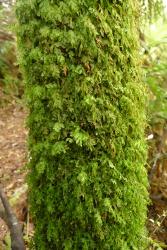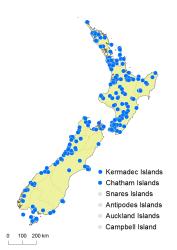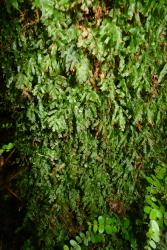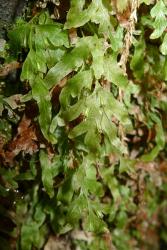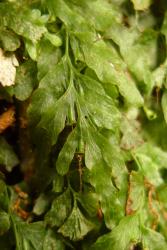- ≡ Phlebiophyllum venosum (R.Br.) Bosch, Verslagen Meded. Afd. Natuurk. Kon. Akad. Wetensch. 11: 321 (1861)
- ≡ Polyphlebium venosum (R.Br.) Copel., Philipp. J. Sci. 67: 55 (1938)
- ≡ Crepidomanes venosum (R.Br.) Bostock in Bostock & Spokes, Fl. Austral. 48, 706 (1998)
- = Trichomanes venustulum Colenso, Trans. & Proc. New Zealand Inst. 12: 366 (1880) – as venustula
Epiphytic, or rarely rupestral ferns. Rhizomes long-creeping, filiform, c. 0.2 mm diameter, bearing dense red-brown hairs up to 0.5 mm long. Fronds 25–165 mm long. Stipes 8–50 mm long, rarely to 80 mm long, dark brown proximally, becoming pale brown distally, not winged, glabrous or with a few short scattered hairs. Laminae 1-pinnatifid near apex to 1-pinnate or 1-pinnate-pinnatifid at base, rather irregular in outline (generally elliptic or obovate), 15–140 mm long, 6–60 mm wide, light green, membranous, glabrous or bearing very short scattered hairs along the veins. Rachises not winged or winged only near lamina apex, pale brown, glabrous or bearing short scattered hairs. Primary pinnae in 3–16 pairs, widely spaced; undivided primary pinnae oblong, crenate, 5–60 mm long, 1.5–4 mm wide; divided primary pinnae ovate, slightly or irregularly lobed or with 1–3 sometimes greatly extended pinnatifid segments, 10–60 mm long, 4–23 mm wide; distal primary pinnae adnate; proximal primary pinnae stalked; the longest primary pinnae usually at or above the middle. Ultimate segments oblong, up to 17 mm long, 1.2–3.5 mm wide, with veins forking many times in each; apices obtuse or truncate or emarginate; margins shallowly lobed to crenate, lacking a distinct border. Sori borne acroscopically near bases of primary pinnae, 1 or rarely 2 on each primary pinna, either partially immersed in lamina or free and stalked; indusia tubular, 1.5–2.5 mm long, widened at mouth; sporangia borne on a fine receptacle up to 24 mm long, projecting well beyond the indusia at maturity.
Trichomanes venosum is distinguished by its epiphytic habitat, light green translucent fronds, and prominent veins which fork many times in each ultimate lamina segment.
It is superficially similar to, and occupies the same habitat as, T. caudatum, but can be distinguished by its unbordered and emarginate lamina segments, and ultimate lamina segments with veins forking many times in each.
North Island: Northland, Auckland, Volcanic Plateau, Gisborne, Taranaki, Southern North Island.
South Island: Western Nelson, Sounds Nelson, Marlborough, Westland, Canterbury, Otago, Southland, Fiordland.
Kermadec Islands, Chatham Islands, Solander Island, Stewart Island.
Altitudinal range: 0–900 m.
Trichomanes venosum occurs throughout the North Island in wet lowland to montane forest, extending from sea level to 760 m near Erua on the volcanic plateau, and to 900 m in Urewera National Park. In the South Island it occurs from the Marlborough Sounds and north-west Nelson through Westland and Fiordland to Southland, south-east Otago and Banks Peninsula, with isolated populations in Marlborough and inland Canterbury. It is largely confined to lowland forest, but reaches nearly 500 m on D’Urville Island and 600 m on Banks Peninsula.
Also Australia (Queensland, New South Wales, Victoria, Tasmania).
Occurs most commonly on tree fern trunks, especially Cyathea dealbata, C. smithii and Dicksonia squarrosa, in podocarp, beech, broadleaved and kānuka forest. Occasionally it is found on Cyathea medullaris, Weinmannia racemosa or Melicytus ramiflorus trunks, on fallen trunks, damp banks, or on wet rock faces and overhangs.
n = 36 (Brownlie 1954).
In the classification of Ebihara et al. (2006), Trichomanes venosum is treated as Polyphlebium venosum.
Trichomanes venosum was described from Tasmania and New South Wales, Australia by Brown (1810) as "D" (Insula Van Diemen) and "J" (the area from Sydney north to Newcastle). There is one sheet at BM labelled "Derwent, Ins. Van Diemen, 1804, R. Brown, No. 96" (BM 1044772), and another at K labelled "Derwent, R. Brown No. 96" (photo WELT E469/16). Tindale (1963) referred to these as the holotype and isotype respectively, but did not mention another specimen labelled "Derwent, R. Brown No. 96" (E 00208910). We interpret these as separate syntypes, with Tindale’s statement of "holotype" constituting effective lectotypification. There are other possible syntype specimens collected by Brown from Tasmania at LE, MEL and US.



